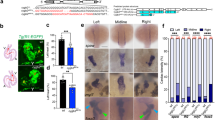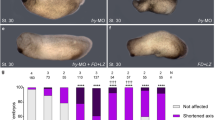Abstract
Cilia are cell surface organelles found on most epithelia in vertebrates. Specialized groups of cilia have critical roles in embryonic development, including left–right axis formation. Recently, cilia have been implicated as recipients of cell–cell signalling1,2. However, little is known about cell–cell signalling pathways that control the length of cilia3. Here we provide several lines of evidence showing that fibroblast growth factor (FGF) signalling regulates cilia length and function in diverse epithelia during zebrafish and Xenopus development. Morpholino knockdown of FGF receptor 1 (Fgfr1) in zebrafish cell-autonomously reduces cilia length in Kupffer’s vesicle and perturbs directional fluid flow required for left–right patterning of the embryo. Expression of a dominant-negative FGF receptor (DN-Fgfr1), treatment with SU5402 (a pharmacological inhibitor of FGF signalling) or genetic and morpholino reduction of redundant FGF ligands Fgf8 and Fgf24 reproduces this cilia length phenotype. Knockdown of Fgfr1 also results in shorter tethering cilia in the otic vesicle and shorter motile cilia in the pronephric ducts. In Xenopus, expression of a dn-fgfr1 results in shorter monocilia in the gastrocoel roof plate that control left–right patterning4 and in shorter multicilia in external mucociliary epithelium. Together, these results indicate a fundamental and highly conserved role for FGF signalling in the regulation of cilia length in multiple tissues. Abrogation of Fgfr1 signalling downregulates expression of two ciliogenic transcription factors, foxj1 and rfx2, and of the intraflagellar transport gene ift88 (also known as polaris), indicating that FGF signalling mediates cilia length through an Fgf8/Fgf24–Fgfr1–intraflagellar transport pathway. We propose that a subset of developmental defects and diseases ascribed to FGF signalling are due in part to loss of cilia function.
This is a preview of subscription content, access via your institution
Access options
Subscribe to this journal
Receive 51 print issues and online access
$199.00 per year
only $3.90 per issue
Buy this article
- Purchase on Springer Link
- Instant access to full article PDF
Prices may be subject to local taxes which are calculated during checkout




Similar content being viewed by others
References
Eggenschwiler, J. T. & Anderson, K. V. Cilia and developmental signaling. Annu. Rev. Cell Dev. Biol. 23, 345–373 (2007)
Gerdes, J. M. et al. Disruption of the basal body compromises proteasomal function and perturbs intracellular Wnt response. Nature Genet. 39, 1350–1360 (2007)
Park, T. J., Mitchell, B. J., Abitua, P. B., Kintner, C. & Wallingford, J. B. Dishevelled controls apical docking and planar polarization of basal bodies in ciliated epithelial cells. Nature Genet. 40, 871–879 (2008)
Schweickert, A. et al. Cilia-driven leftward flow determines laterality in Xenopus . Curr. Biol. 17, 60–66 (2007)
Albertson, R. C. & Yelick, P. C. Roles for fgf8 signaling in left–right patterning of the visceral organs and craniofacial skeleton. Dev. Biol. 283, 310–321 (2005)
Boettger, T., Wittler, L. & Kessel, M. FGF8 functions in the specification of the right body side of the chick. Curr. Biol. 9, 277–280 (1999)
Fischer, A., Viebahn, C. & Blum, M. FGF8 acts as a right determinant during establishment of the left–right axis in the rabbit. Curr. Biol. 12, 1807–1816 (2002)
Meyers, E. N. & Martin, G. R. Differences in left–right axis pathways in mouse and chick: functions of FGF8 and SHH. Science 285, 403–406 (1999)
Tanaka, Y., Okada, Y. & Hirokawa, N. FGF-induced vesicular release of Sonic hedgehog and retinoic acid in leftward nodal flow is critical for left–right determination. Nature 435, 172–177 (2005)
Long, S., Ahmad, N. & Rebagliati, M. The zebrafish nodal-related gene southpaw is required for visceral and diencephalic left–right asymmetry. Development 130, 2303–2316 (2003)
Roehl, H. & Nusslein-Volhard, C. Zebrafish pea3 and erm are general targets of FGF8 signaling. Curr. Biol. 11, 503–507 (2001)
Amack, J. D. & Yost, H. J. The T box transcription factor no tail in ciliated cells controls zebrafish left–right asymmetry. Curr. Biol. 14, 685–690 (2004)
Essner, J. J., Amack, J. D., Nyholm, M. K., Harris, E. B. & Yost, H. J. Kupffer’s vesicle is a ciliated organ of asymmetry in the zebrafish embryo that initiates left–right development of the brain, heart and gut. Development 132, 1247–1260 (2005)
Kramer-Zucker, A. G. et al. Cilia-driven fluid flow in the zebrafish pronephros, brain and Kupffer’s vesicle is required for normal organogenesis. Development 132, 1907–1921 (2005)
Nonaka, S. et al. Randomization of left–right asymmetry due to loss of nodal cilia generating leftward flow of extraembryonic fluid in mice lacking KIF3B motor protein. Cell 95, 829–837 (1998)
Amack, J. D., Wang, X. & Yost, H. J. Two T-box genes play independent and cooperative roles to regulate morphogenesis of ciliated Kupffer’s vesicle in zebrafish. Dev. Biol. 310, 196–210 (2007)
Amaya, E., Musci, T. J. & Kirschner, M. W. Expression of a dominant negative mutant of the FGF receptor disrupts mesoderm formation in Xenopus embryos. Cell 66, 257–270 (1991)
Millimaki, B. B., Sweet, E. M., Dhason, M. S. & Riley, B. B. Zebrafish atoh1 genes: classic proneural activity in the inner ear and regulation by Fgf and Notch. Development 134, 295–305 (2007)
Riley, B. B., Zhu, C., Janetopoulos, C. & Aufderheide, K. J. A critical period of ear development controlled by distinct populations of ciliated cells in the zebrafish. Dev. Biol. 191, 191–201 (1997)
Lee, Y., Grill, S., Sanchez, A., Murphy-Ryan, M. & Poss, K. D. Fgf signaling instructs position-dependent growth rate during zebrafish fin regeneration. Development 132, 5173–5183 (2005)
Pownall, M. E. et al. An inducible system for the study of FGF signalling in early amphibian development. Dev. Biol. 256, 89–99 (2003)
Zhang, X. et al. Receptor specificity of the fibroblast growth factor family. The complete mammalian FGF family. J. Biol. Chem. 281, 15694–15700 (2006)
Scholpp, S., Groth, C., Lohs, C., Lardelli, M. & Brand, M. Zebrafish fgfr1 is a member of the fgf8 synexpression group and is required for fgf8 signalling at the midbrain–hindbrain boundary. Dev. Genes Evol. 214, 285–295 (2004)
Draper, B. W., Stock, D. W. & Kimmel, C. B. Zebrafish fgf24 functions with fgf8 to promote posterior mesodermal development. Development 130, 4639–4654 (2003)
Fischer, S., Draper, B. W. & Neumann, C. J. The zebrafish fgf24 mutant identifies an additional level of Fgf signaling involved in vertebrate forelimb initiation. Development 130, 3515–3524 (2003)
Urban, A. E. et al. FGF is essential for both condensation and mesenchymal–epithelial transition stages of pronephric kidney tubule development. Dev. Biol. 297, 103–117 (2006)
Brody, S. L., Yan, X. H., Wuerffel, M. K., Song, S. K. & Shapiro, S. D. Ciliogenesis and left–right axis defects in forkhead factor HFH-4-null mice. Am. J. Respir. Cell Mol. Biol. 23, 45–51 (2000)
Bonnafe, E. et al. The transcription factor RFX3 directs nodal cilium development and left–right asymmetry specification. Mol. Cell. Biol. 24, 4417–4427 (2004)
Bisgrove, B. W., Snarr, B. S., Emrazian, A. & Yost, H. J. Polaris and Polycystin-2 in dorsal forerunner cells and Kupffer’s vesicle are required for specification of the zebrafish left–right axis. Dev. Biol. 287, 274–288 (2005)
The R Development Core Team. The R Foundation for Statistical Computing 〈http://www.r-project.org/foundation/〉 (2007)
Thummel, R. et al. Inhibition of zebrafish fin regeneration using in vivo electroporation of morpholinos against fgfr1 and msxb . Dev. Dyn. 235, 336–346 (2006)
Draper, B. W., Morcos, P. A. & Kimmel, C. B. Inhibition of zebrafish fgf8 pre-mRNA splicing with morpholino oligos: a quantifiable method for gene knockdown. Genesis 30, 154–156 (2001)
Nieuwkoop, P. D. & Faber, J. Normal Table of Xenopus Laevis (Daudin): A Systematical and Chronological Survey of the Development From the Fertilized Egg Till the End of Metamorphosis (Garland, 1994)
Acknowledgements
We thank A. Moon and M. Condic for critical discussions on the manuscript; M. Karthikeyan, J. Shen, D. Coombs and E. Martini for technical help; and S. Miyagawa-Tomita, K. Poss and H. Issacs for reagents. This work was supported by American Heart Association predoctoral fellowship to J.M.N., NRSA Postdoctoral fellowship to J.D.A. and grants from NHLBI, NICHD and Primary Children’s Medical Foundation to H.J.Y.
Author Contributions J.M.N. performed all zebrafish experiments except KV flow analysis (by J.D.A.) and Xenopus experiments (by A.G.P.). B.W.B. cloned zebrafish foxj1, rfx2 and ift88. J.M.N. and H.J.Y. wrote the manuscript with input from all co-authors.
Author information
Authors and Affiliations
Corresponding author
Supplementary information
Supplementary Figures
This file contains Supplementary Figures 1-7 with Legends (PDF 478 kb)
Supplementary Movie 1
This movie shows a dorsal view of the tailbud of a live Control morphants injected with fluorescent beads at 6-8 SS. DIC shows position of KV relative to the midline (notochord). Fluorescent imaging shows a counterclockwise flow of beads within KV, with an average bead velocity of 11.26 µM/sec (39 beads, 8 embryos). The green line circumscribes the KV. (MOV 9779 kb)
Supplementary Movie 2
This movie shows a dorsal view of the tailbud of a live fgfr1 morphant injected with fluorescent beads at 6-8 SS. DIC shows position of KV relative to the midline (notochord). Fluorescent imaging shows no persistent directional flow of beads, and a significantly reduced absolute velocity of 5.23 µM/sec (44 beads, 9 embryos). The green line circumscribes the KV. (MOV 10648 kb)
Rights and permissions
About this article
Cite this article
Neugebauer, J., Amack, J., Peterson, A. et al. FGF signalling during embryo development regulates cilia length in diverse epithelia. Nature 458, 651–654 (2009). https://doi.org/10.1038/nature07753
Received:
Accepted:
Published:
Issue Date:
DOI: https://doi.org/10.1038/nature07753
This article is cited by
-
R-Spondin 2 governs Xenopus left-right body axis formation by establishing an FGF signaling gradient
Nature Communications (2024)
-
Genetics, pathobiology and therapeutic opportunities of polycystic liver disease
Nature Reviews Gastroenterology & Hepatology (2022)
-
Theobroma cacao improves bone growth by modulating defective ciliogenesis in a mouse model of achondroplasia
Bone Research (2022)
-
FGF8 induces epithelial-mesenchymal transition and promotes metastasis in oral squamous cell carcinoma
International Journal of Oral Science (2021)
-
Prdx1 promotes the loss of primary cilia in esophageal squamous cell carcinoma
BMC Cancer (2020)
Comments
By submitting a comment you agree to abide by our Terms and Community Guidelines. If you find something abusive or that does not comply with our terms or guidelines please flag it as inappropriate.



